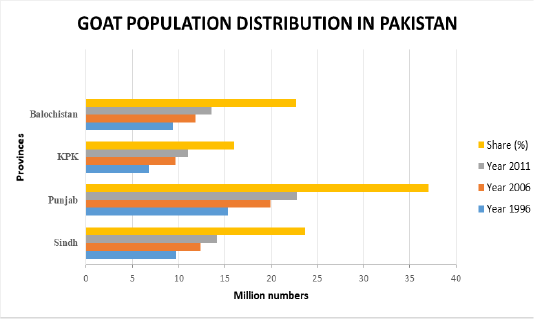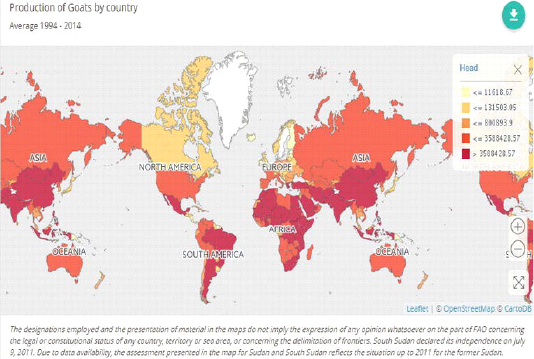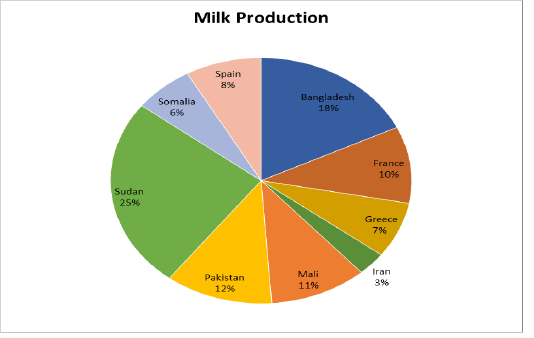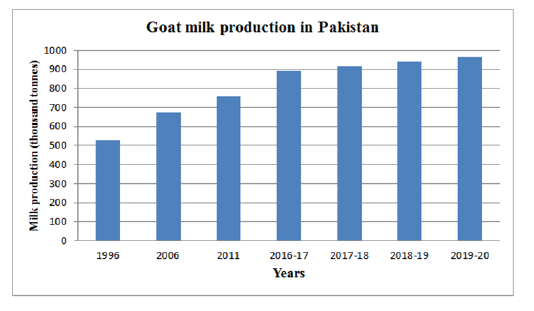Journal of Animal Health and Production
Review Article
Production Potential, Nutritive Value and Nutraceutical Effects of Goat Milk
Arab Lund1, Muhammad Ahmad2*
1Department of Animal Production and Technology, Shaheed Benazir Bhutto University of Veterinary and Animal Sciences, Sakrand-67210; 2Faculty of Veterinary Sciences, Shaheed Benazir Bhutto University of Veterinary and Animal Sciences, Sakrand-67210, Sindh, Pakistan.
Abstract | Goat is the choice of a poor farmer because they can easily adaptable, least cost in farming and low agriculture land. There are more than 500 different goat breeds in the world. Among these many are popular for their milk production potential and known as dairy goats. The most famous dairy goat breeds of Pakistan are Kamori, Beetal and Pateri. Kamori is considered as the cow of the poor farmer as it is good in milk production. The goat milk is well known for its unique characteristics to include an alternative for cow milk allergen people, easily digestible for infant, buffer capacity and higher content of mineral zinc, iron and magnesium. Caprine milk shows the therapeutic effects of various conditions such as anaemia, asthma, stomach ulcer, constipation, insomnia and neurotic indigestion. Novel angiotensin-converting enzyme inhibitory proteins released by gastric pepsin of goat milk caseins and whey proteins have been proved as a potent candidate against hypertension and associated diseases. Goat milk also utilized for preparing value-added milk products to include cheese, butter, paneer, ghee and ice cream. This review was designed to focus on the goat population, milk yield, milk products, nutraceutical effects and characteristics of goat milk.
Keywords | Capra hircus; Goat Population; Milk Production; Therapeutics Properties; Milk Products.
Received | July 15, 2020; Accepted | August 05, 2020; Published | December 01, 2020
*Correspondence | Muhammad Ahmad, Faculty of Veterinary Sciences, Shaheed Benazir Bhutto University of Veterinary and Animal Sciences, Sakrand-67210, Sindh, Pakistan; Email: mahmad118@yahoo.com
Citation | Lund A, Ahmad M (2021). Production potential, nutritive value and nutraceutical effects of goat milk. J. Anim. Health Prod. 9(1): 65-71.
DOI | http://dx.doi.org/10.17582/journal.jahp/2021/9.1.65.71
ISSN | 2308-2801
Copyright © 2021 Lund and Ahmad. This is an open access article distributed under the Creative Commons Attribution License, which permits unrestricted use, distribution, and reproduction in any medium, provided the original work is properly cited.
INTRODUCTION
Goats (Capra hircus) are the first small domesticated ruminants that have been serving mankind longer than other ruminants and used for dual purpose, milk and meat since 2500 B.C (Dubeuf and Boyazoglu, 2009; Mirzaei, 2012). Goats are spread throughout the globe due to their capability to adapt in different environmental conditions. Worldwide, their population is about 617 million from which 97.3% found in the developing countries i.e., Asia 65.9%, Africa 27.4%, Europe 3.5% and America 3.0%. Among these, 191 million goat populations are used for dairy purpose (FAO, 2012). It has been estimated that there is 78.2 million goat population in Pakistan and their milk production is about 965 thousand tonnes (Pakistan Economic Survey, 2019-20). Pakistan ranked third in goat producing all over the world (Hasan et al., 2016). Goats are also considered as fastest growing small ruminants in Pakistan. They have a major contribution to various families in rural areas as the old saying; the goat is the cow of poor people.
Goats are an important source of human nutrition by providing animal origin protein (Hokmollahi & Ehsani, 2020). Goat milk is being consumed more than that of other species (Getaneh et al., 2016). It is characterized by therapeutic value, higher digestibility and buffer capacity (Lad et al., 2017). It is an alternative source for the allergen people from cow milk or any other food sources (Ceballos, 2009). Its’ remedial effects were observed against mal-absorption syndromes, hyperlipoproteinnemia, coronary bypass, chyluria, childhood epilepsy, allergy, gastric ulcer and gallstones (Roy, 2006). Novel angiotensin-converting enzyme (ACE) inhibitory proteins released by gastric pepsin of goat milk caseins and whey proteins have been proved as a potent candidate against hypertension and associated diseases (Ibrahim et al., 2017). It is a second best option after mothers’ milk for infants because of unique composition. Goat milk contain many fold higher calcium and phosphorus than human milk. Moreover, the size of fat globules of goat milk is much smaller than bovine milk (Getaneh et al., 2016). Infants after consuming goat milk were observed very satisfied and had a good sleep (Park, 2006a). The present review article highlighted the milk production and compositional characteristics of goat milk as well as its’ therapeutic importance to gather the focus of researchers to dig more research on goats and goat milk.
Goat Population
In last five decades, goat population have increased about 240% as compared to other livestock that have no or little increase in their numbers. Currently there are about one billion goats on the globe and among these about 90% are found in Africa and Asia (Capote, 2014). In 1994, global goat population was around 600 million heads which reached to over 1 billion in 2014, a 67% upsurge in just twenty years (Figure 1; FAO, 2017).
In Pakistan, the total population of goats is 78.2 million (Pakistan Economy survey, 2019-20). Goats are good source of income for 6 million people especially for landless people. There are various breeds of goat scattered through the four states of Pakistan, Punjab 37% Sindh 23.7%, Baluchistan 22.7% and Khyber Pakhtunkhwa 16% as shown in Figure 2. Breeds are categorized on the basis of some similarities of goats such as colour, horns, milk and meat production, etc. There are 36 breeds of goat in Pakistan in addition to 2 wild breeds, Markhor and Ibex (Khan, 2008; Muayad et al., 2019). All breeds are used for dual purpose, milk and meat; however, five breeds are well recognized for the milk production i.e., Beetal, Kamori, Dera Din Panah, Damani and Nachi (Muner et al.., 2018). Population of Kamori breed is 5.29 million heads that is highest among all local dairy breeds (Table 1).
Table 1: Common dairy goat breeds of Pakistan [Million Numbers] (Livestock Census, 2006)
| Provinces | Breeds | ||||
| Beetal | Kamori | Damani | Dera din panah | Nachi | |
| Punjab | 3.11 | 0.04 | 0.05 | 0.075 | 0.03 |
|
Khyber Pakhtunkhwa (KPK) |
0.65 | 0.05 | 0. 9 | 0.045 | 0.018 |
| Sindh | 0.24 | 3.9 | 0.03 | 0.015 | 0.026 |
| Balochistan | 0.21 | 1.30 | 0.33 | 0.006 | 0.035 |
| Total | 4.21 | 5.29 | 1.31 | 0.14 | 0.11 |

Figure 2: Distribution of goat breeds in different provinces of Pakistan (Economic Survey 2010-2011)
Note: KPK= Khyber Pakhtunkhwa
Goat Milk Yield
Globally, the dairy goat population is about 218 million and the average milk production is about 18.7 million tonnes (MT) in the year 2017 (FAO, 2019). Milk yield of goats is varied area to area and country to country as shown in Figure 3. Goat production shares 2.3% in the total milk production, worldwide. Most of the goat milk is utilized for self-consumption; however, a small portion also used for the value-added products i.e., cheese and candies. In the United Kingdom, goat milk (15-20 million litters) is processed every year (Joon et al., 2017). The consumption of goat milk is increasing day by day due to the increase in the human population, therefore, goat is considered as the cow of the poor man (Park and Haenlein, 2007; Lad et al., 2017). Secondly, it is widely used for different products in the developing countries (Mowlem, 2005). Lastly, goat milk is well known for therapeutical purpose as people who have allergy from the cow milk. Ribeiro, (2008) reported that goat milk is used for pet consumption and pet care products as well.
In Pakistan, goat milk production is also increasing day by day as shown in Figure 4. The average lactation yield of some local dairy goat breeds is reported as: Beetal (195 lit
ers/224days), Damani (110liters/110days), Dera Din Panah (245 litters/135 days), Naachi (110 litters/100days) and Kamori (210 litters/115days) (Iqbal et al., 2008; Kumsa, 2019).
Physical and Chemical Characteristics of Goat Milk
Goat milk has intense flavour due to short chain fatty acid and white colour due to conversion of carotene. Goats have
the capability to convert all beta carotene into vitamin A because of that the colour of goat milk is white (Yakan et al., 2019; Ranadheera et al., 2019). Goat milk is alkaline in nature, has lower lactose and a greater amount of chloride, fat, mineral and vitamins in comparison to cow milk (Park, 2005). The composition of goat milk reported by different workers has been presented in Table 2, and it has been observed that various factors such as breed, geographical location, milking stage, season, nutrition etc., may largely effect on goat milk composition (Nehru et al., 2018; Tyasi et al., 2020). Rafiq et al. (2016) reported that the goat milk is composed of total solid (12-13.5%), protein (3.5%), fat (3.8-4.5%), lactose (4.1%) and minerals (0.8%). Further, Park, (2005) stated that the goat milk contains a low amount of casein protein and a high amount of non-protein nitrogen (NPN). Goat milk characterized by high digestibility due to the small size of fat globule and small soft and friable curd (during stomach acidification) than that of milk contain large size fat globules (Park, 2006a). Goat milk contains 12-18% total solid and 3-4.5% protein (Haenlein, 1993). Cerbulis et al. (1985) found that the goat milk contains 98% free lipids and 1-3% bounded to make phospholipids. Goat milk is well known for glutamate, proline and leucine amino acids (Rafiq et al., 2016). It resembles human milk on the basis of oligosaccharide. It contains essential minerals (calcium 134mg and phosphorus 141 mg per 100g) as reported by researchers (Park, 2006b; Yangilar, 2013). However, Posati and Orr, (1976) reported that the goat milk contains a lower amount of minerals than that of sheep milk (phosphorus 270mg, chloride 154mg, sodium 50mg, potassium 204mg and calcium 194mg per 100g). Alkaline phosphatase enzyme found at lower concentration in goat milk (Magariños et al., 2007).
Value Added Goat Milk Products
Worldwide, goats are reared for milk, meat, hair, bones, skin and horns (Kalyan et al., 2018; Amundson, 2019). In Pakistan, goats are mostly used for milk, meat and fibre production (Hasnain, 1985). Pandya and Ghodke, (2007) reported the different products of goat milk such as dry milk, condensed milk, whey protein, concentrated and evaporated milk, cheese, butter, paneer, ghee and ice cream as shown in Table 3. Pirisi et al. (2007) stated that people use goat milk as in fashion as different beauty products such as soaps and lotions are prepared and have great demand in the market by women for their beautification.
Nutraceutical Effects of Goat Milk
Goat milk has been showing numerous medical properties as shown in Table 4. It is the most common alternative for people who have a cow milk allergy (Risko and Csapo, 2019). Furthermore, goat milk is used for different diseases such as acidity, stomach ulcer, asthma, insomnia, constipation, and neurotic indigestion (Clark and Garcia, 2017). Goat milk exhibits biological properties as it contains a higher amount of protein, phosphate, and non-protein nitrogen NPN that makes it highly digestible and has a good buffering capacity (Lad et al., 2017; Clark and Garcia, 2017; Nasir et al., 2018). Goat milk is also utilized for the young one of many species including human beings that’s why it is known as the universal foster mother (Mowlem, 2005). Studies have reported that the rats affected by anaemia showed a greater growth rate on goat milk consumption in comparison to cow milk (Gaucheron, 2013). Goat milk performs various biological functions under enzymatic hydrolysis such as increased blood flow to the intestinal epithelium, probiotic activity, mineral binding capacity, and improved immunity and antimicrobial activity (Maestri et al., 2019). Bioactive components are released under
Table 2: Chemical characteristics of goat milk
Studies | Milk constituents | |||||||
| Fat % | Protein % | Lactose % | Mineral % | Casein % | Solid not fat % | Moisture % | Energy (Cal. Per 100ml) | |
Anifantakis et al., 1980 | 3.8 | 3.4 | 4.1 | 0.8 | 2.4 | 8.9 | 87.9* | 70 |
Haenlein & Caccese, 1984 | 3.8 | 3.5 | 4.1 | 0.8 | - | 8.4* | 87.8* | - |
| Saini & Gill, 1991 | 3.8 | 2.9 | 4.0 | 0.8 | 2.4 | 10.3 | 88.5* | 70 |
El-Alamy et al., 1990 | 4.0 | 2.9 | 3.9 | 0.8 | - | 12.3 | 88.4* | - |
Sawaya et al., 1984 | 3.0 | 3.4 | 4.5 | 08 | - | 8.7* | 88.3* | - |
| Szymanowska & Lipecka 1997 | 4.1 | 2.9 | - | 0.8 | - | - | - | - |
| Park & Haenlein, 2007 | 3.8 | 3.5 | 4.1 | 0.8 | - | 12.2 | 87.8* | - |
| Banerjee, 2018 | 4.3 | 3.5 | - | - | - | - | - | 87 |
* shows the value made by difference formula
Table 3: Value added goat milk products
| Milk products | Studies |
| Fluid milk | Loewenstein et al., 1980; Ribeiro and Ribeiro, 2010 |
| Evaporated and dried milk | Park, 2005; Pandya and Ghodke, 2007 |
| Cheese | Park, 2001 |
| Fermented milk (Kefir) | Morand-Fehr et al., 2007; Farnworth, 2005 |
| Desserts (Ice cream and Chakka) | Prajapati and Nair, 2003; Park, 2005; Correia et al., 2008 |
| Sweets | Park and Guo, 2006; Ribeiro and Ribeiro, 2010 |
| Butter like products (Cream and Ghee) | Rodriguez et al., 2003 Mowlem, 2005; Park, 2005; |
| Whey products | Pandya and Ghodke, 2007 |
| Cosmetics | Ribeiro et al., 2007 |
Table 4: Nutraceutical effects of goat milk and its constituents.
| Nutraceutical Effects | Milk /milk Constituents | References |
| Anti-cow milk allergy | Goat milk | Risko and Csapo, 2019 |
| Acidity, stomach ulcer, asthma, insomnia, constipation, and neurotic indigestion | Goat milk | Lad et al., 2017; Clark and Garcia, 2017 |
| Digestibility and buffering capacity | Goat milk protein, phosphate, and non-protein nitrogen | Lad et al., 2017; Clark and Garcia, 2017; Nasir et al., 2018 |
| Anaemia | Goat milk | Gaucheron, 2013 |
| Immunomodulation | Goat milk proteins | Lad et al., 2017; Yaser et al., 2018 |
| Maintain blood pressure and prevent cardiovascular diseases | Goat milk potassium and nitrogen | Barrionuevo et al., 2002
|
| Bone mineralization | Goat milk phosphorus and calcium | Barrionuevo et al., 2002 |
| Arthritis | Goat milk bioorganic sodium | Getaneh et al., 2016 |
| Malabsorption syndromes | Goat milk medium-chain fatty acids like capric, caprylic and caproic | Sampelayo et al., 2007 |
Intestinal inflammation, brain development, antidiabetic, and anti-cancer | Goat milk | Claps et al., 2014 |
| Gut microbiome modulation | Goat milk | Ceapa et al., 2013 |
Probiotic like effect | Goat milk (Folate-binding protein, protease peptone, prolactin, transferring, lactoferrin and ferritin) | Lima et al., 2018 |
the hydrolysis of milk protein that has a positive impact on the different functions of the body (Korhonen and Pihlanto, 2003). Goat milk also contains lactoferrin, transferring and prolactin as well which are important for the different functions of the body such as immunity, milk production, etc. (Lad et al., 2017; Yaser et al., 2018). Goat milk is a rich source of potassium and nitrogen, which are the essential elements to maintain blood pressure and prevent cardiovascular diseases. It also improve bone mineralization by improving the digestive and metabolic use of phosphorus and calcium. Consumption of goat milk also enhance the utilization of copper and iron (Barrionuevo et al., 2002). Moreover, goat milk also provide bioorganic sodium that is known to prevent arthritis (Getaneh et al., 2016). Goat milk contain many medium-chain fatty acids like capric, caprylic and caproic, which have pharmacological effects against malabsorption syndromes (Sampelayo et al., 2007).
Oligosaccharides, a well known class of bioactive compounds which have several beneficial effects like protective action against intestinal inflammation, immunomodulation and brain development, relief in constipation, antidiabetic, improvement in mineral absorption, and reduced incidence of colonic cancer etc., are found 4-5 times higher in goat milk as compared to bovine milk (Claps et al., 2014). Goat milk also contain a significant amount of probiotics (bacterial organisms providing beneficial effects on host health) that produce several types of physiologically active metabolites in the intestine that have nutraceutical properties (Lima et al., 2018). It’s also known to modulate gut microbiome and regulate it for inflammatory and immune processes (Ceapa et al., 2013). In addition to casein which is 80% in goat milk, there are several other minor proteins in goat milk that have nutraceutical properties including folate-binding protein, protease peptone, prolactin, transferring, lactoferrin and ferritin (Lima et al., 2018). ACE is a multifunctional enzyme that also known as a principal regulator of blood pressure. ACE inhibition, confine the formation of angiotensin II or block its receptors that results arteriolar vasodilation and a decrease in total peripheral resistance (Acharya et al., 2003). Recent studies have proved that goat milk and milk products have significant effects on ACE inhibition (Ibrahim et al., 2017).
Conclusion
The goat population showed an increasing trend year wise as the people show interest in goat rearing. They are easily adaptable and have little cost of invest in farming in comparison to large ruminants. In addition to that, they are fast growers than that of large ruminants. Goat milk plays a vital role in milk demand especially in rural areas because the goat is the cow of poor people. Goat milk has been utilized for several value-added products as they have great demand in the market due to therapeutic properties, easily digestibility and buffer capacity in comparison to the milk of other animals. Goat milk is the best alternative of bovine milk and have no or little allergens. It considered most suitable for infants because it is easily digestible and shows a somewhat similar composition to human milk. Goat milk shows superior characteristics over the cow milk. It shows nutraceutical effects for various conditions including malnutrition, poor mineral absorption, constipation, colonic cancer, blood pressure and inflammation.
Acknowledgment
This review did not receive specific grant from any funding agency in the public, commercial or non-profit sectors.
conflict of interest
There is no conflict of interest.
Author’s contribution
AL design and wrote the manuscript. MA searched the literature and reviewed the manuscript.
REFERENCES
syndrome. J. Dairy Sci. 85(3): 657-664.
Sialyloligosaccharides content in colostrum and milk of two goat breeds. Small Rumin.
Res. 121(1):116-119.
constituents of goat and sheep milk. Small Rumin. Res. 68(1):42-63.









